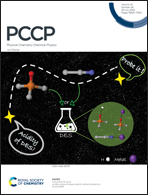16OSTM10: a new open-shell transition metal conformational energy database to challenge contemporary semiempirical and force field methods†
Abstract
A new database, 16OSTM10, containing 10 conformations for each of 16 non-multireference realistic-size open-shell transition metal (OSTM) complexes has been developed. Contemporary composite density functional theory (DFT) (PBEh-3c and B97-3c), semiempirical (PM6 and PM7) and the GFNn-xTB/FF family methods were examined against conventional DFT (PBE-D3(BJ), PBE0-D3(BJ), M06 and ωB97X-V) to reproduce the conformational energies. While good performance is observed for the conventional (the average Pearson correlation coefficient is ρ = 0.91) and composite DFT (average ρ = 0.93), semiempirical and force-field methods should still be used with caution for these challenging compounds. The corresponding average ρ values are 0.53 (PM6 and PM7), 0.75 (GFN1-xTB and GFN2-xTB) and 0.62 (GFN-FF). Accounting for the intramolecular dispersion interactions turned out to be crucial for 4 OSTM complexes bearing bulky substituents in close proximity to each other. The influence of the scalar relativistic effects on the conformational energies is negligible for the considered 3d metal species.



 Please wait while we load your content...
Please wait while we load your content...